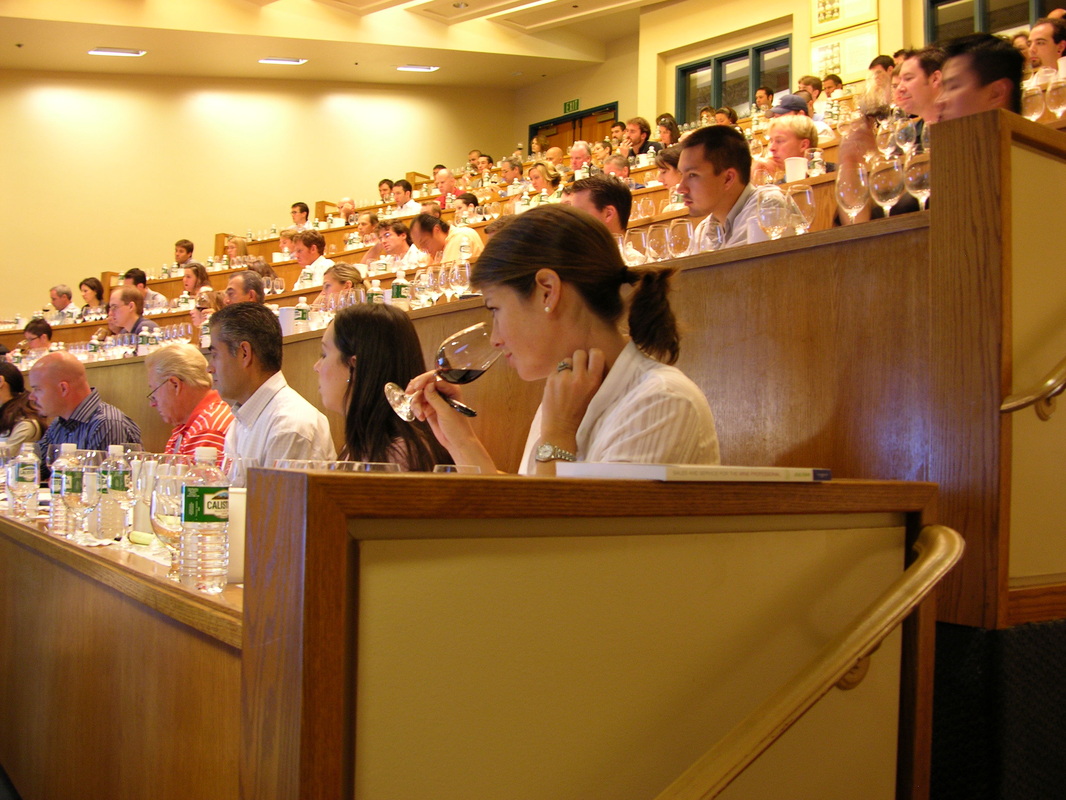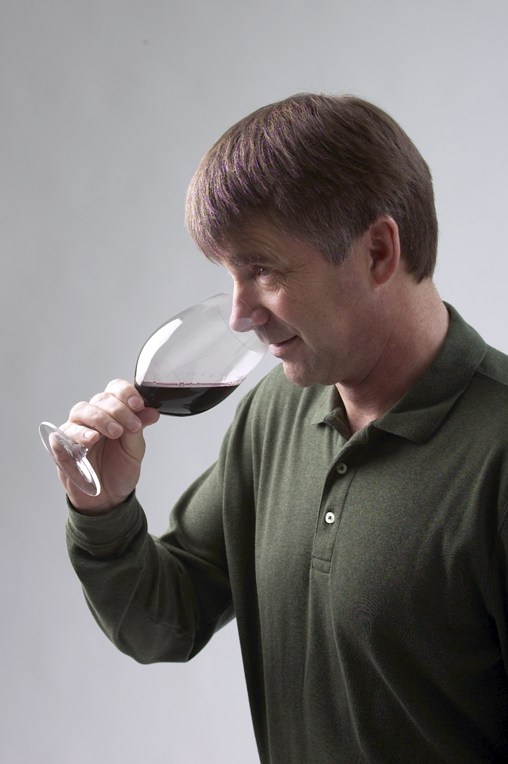n
Glassware Stance
The Grip
Always hold the glass by the stem, please. Holding the glass by the bowl may work for Bud Lite, pirate’s grog, or tomorrow morning’s cup of coffee, but it’s remarkably tacky when applied to holding a wine glass. You can only imagine what I think of stemless glassware.
Positioning
I once saw George Riedel, the George Riedel of Riedel Crystal, teach a group to smell wine by instructing them to gently place the rim of the glass on their upper lip just beneath their nose. After many years of teaching and observation, I’m more than willing to concede that this technique works for 90-plus percent of the population. It’s a good starting point for practically anyone. However, it’s never worked for me. More on that later.
Angle
Once the glass is smartly planted just beneath your nose, it’s time to ponder the best angle to hold said glass to get the most out of the aromas in the wine. There’s definitely a sweet spot for any glass. To find that spot, start with the glass vertically placed underneath your nose and then slowly angle the glass upwards stopping, of course, short of 90,° which is also the point at which you’ll find yourself hoovering the wine making everyone around you wonder about your recreational habits. At some point between 45° and 50° the glass will show its best and you’ll really be able to smell all the aromas in the wine. Note the specific spot/angle and stick with it—but be aware that the sweet spot changes with different kinds and shapes of glasses. No worry, as a quick check will reveal the sweet spot in any wine glass in a matter of seconds.
You might also be curious to discover that as you bring the glass slowly upwards, your head and torso tend to go slightly down. You might also notice that as you reach the spot where you can smell the best, your eyes probably end up looking down in front of you, either straight ahead, slightly to the left, or slightly to the right. It’s different for everyone. This last point may not sound important, but it’s actually vitally important to being able to mentally process the aromas of the wine in terms of figuring out what’s in the glass compared to previous wines you’ve smelled and tasted. In the last year I’ve come to believe that eye positions and memory in tasting wine are closely related.
Intake: Sniff vs. Hoover vs. Retro
Most schools of tasting enthusiastically promote the concept of several short, gentle, and quick sniffs. I completely agree. The “hoover” school of one intense long pull on the glass, however, can result in what I call carpal nasal where your nose shuts down because it’s overwhelmed by alcohol. The hoover technique is obviously to be avoided at all costs when smelling fortified wine or spirits.
Retro-nasal is another smelling technique often bandied about by wine professionals. Though it sounds fancy, it simply involves tasting the wine first, spitting (or swallowing), and then breathing out through the nose. Some professionals swear by it. It’s not overly useful to me unless I have a cold. But try it and see if it works for you. It may be just the thing.
This is the last piece of the Glassware Stance equation and a very important one indeed. I mentioned above that most tasters are content to sniff away with the glass resting directly beneath their nose. Such is not the case for me. Many moons ago when I first got into wine, I distinctly remember struggling with recognizing any aroma in a glass of wine and not being able to figure out why. I also remember going to professional tastings and being surrounded by more experienced people in the industry who blathered on about the floral qualities in such-and-such a white wine, or the used saddle leather notes in a Southern Rhône Valley red. To me, it all just smelled like WINE, be it white, pink, or red. It goes without saying, that I thought wine-speak was somewhere between a carefully orchestrated sham or a delightfully shared group hallucination.
Oddly enough, the answer to my dilemma came in the form of a Cognac master class offered by Rémy Martin in 1988. The Master Blender for Rémy at that time, whose name I unfortunately cannot recall, insisted that fine spirits like Cognac offered multiple layers of aromas, with the most delicate aromas existing far beyond the immediate provenance of the glass. He instructed our group to start smelling the Cognacs with the glass at least 10-12 inches from our face, then proceeding in sequence to positions approximately six inches, three inches, one inch, and finally with our nose directly in the glass.
He also went on to say that for him personally the best way to smell any wine or spirit was to move the glass away from one’s nose by at least an inch (if not more), open one’s mouth about a quarter of an inch, and breathe in and out gently through the nose and mouth at the same time. I tried his suggestion and the difference was instantaneous and dramatic. It literally caused my first major wine epiphany. Immediately, I could not only smell the Cognac in the glass 100% better, but I could also actually recognize several of the aromas. Dear reader, it was as if the clouds had parted, the bright sun was shining, and the angels were singing. I could finally smell—and recognize–something in the glass.
Looking back, I realized that previous to that time when I put my nose directly into a glass, the experience was far too intense and my nose and sense of smell were overwhelmed. Simply pulling the glass away from my face and opening my mouth made all the difference in the world. I’ve come to call this technique “active inhalation” versus the “passive inhalation” of smelling through the nose alone.
Why does active inhalation work better for some people, most importantly me? I really don’t have an answer, but can only surmise that by smelling through my nose and mouth simultaneously, I’ve increased the amount of physiological real estate I use to smell by several hundred percent. Will it work for you? I’m not sure but it’s definitely worth finding out. To do so, simply try the following:
a. Start with the glass resting directly underneath your nose.
b. Move the glass slowly out to at least an inch away from your nose.
c. Make sure the glass is also positioned near your mouth.
d. Open your mouth about ¼ inch.
e. Smell the wine breathing gently through your mouth and nose at the same time.
f. Remember to breathe out—it’s always useful.
g. Test the results: are you able to smell better? Does the change make a difference at all?
In classes over the years, I’ve found pretty consistent results: up to 10% of any group simply cannot make the change. It’s as if I’m trying to get them to throw a baseball with their off hand. From there, I’ve also found that somewhere between 60-70% of any group will experience some (but not much) change by moving to active inhalation. But it’s the last group that always offers a delightful surprise. Somewhere between 10-20% of any group experiences a major and very positive shift. In short, they can immediately smell better as in somewhere between a life-changing and a mystical experience. You may be tempted to scoff, but it’s true. In fact, I clearly remember one man coming up to me after a tasting class completely verklempt. It turned out that hat he had a cleft palate and couldn’t smell practically anything since he was a child. But the simple act of opening his mouth while smelling a glass of wine changed his whole world. I was thrilled for him. These are the moments we live for.
nn

